Collectibles. Fellow German co-blogger Pasco commented recently that collectibles are one of the characteristics of modern games. Also, the always superb Experience Points Podcast discussed collectibles as part of their “In Search of Secrets” Episode. Finally, being an achievement whore myself, collectibles are something I deal with on a regular basis. More than enough reasons to take a closer look at them. And in fact, for such a seemingly simple gameplay element there are quite a few variations on how they can be implemented. So many that I have been struggling to write a definite review. Instead, I decided to start yet another category of posts: the Collectibles Reviews. I will do separate reviews of implementations of collectibles in different games and hopefully, after some time, we will start seeing patterns of what works and why.

Mars. You will never find a more deceitful hive of collectibles and hidden doodads. We must be cautious.
I’d like to start with Red Faction: Guerrilla. For once because it is the game I’m currently playing and as I mentioned in the podcast, a surprisingly decent game. But also because it is a game that has A LOT of collectibles.
Which is already the first question: how many collectibles should there be in a game. I always like to link to this ancient Penny Arcade comic because even back then it was already evident that this mechanic is being abused by many modern games. And it got even worse when achievements and online unlockables arrived. Red Faction: Guerrilla lives up to that cliché… and then some. You collect: ore deposits, radio tags, propaganda billboards and supply crates. The game also keeps track of and rewards you for completing all side-missions, races and demolishon challenges. There are also achievements associated with killing a certain amount of soldiers with the hammer, shooting down a certain amount of planes, doing a certain amount of killing sprees, blowing up hydrogen tanks and doing a certain amount of damage to buildings, etc.. And I’m not even talking of the DLC or the online unlockables. If there is a threshold of too many collectibles, I’m afraid Red Faction: Guerrilla stepped over it. But as you can see, at some point it gets hard to tell if we are still talking of collectibles. So let us begin with the straight-forward ones
Radio Tags
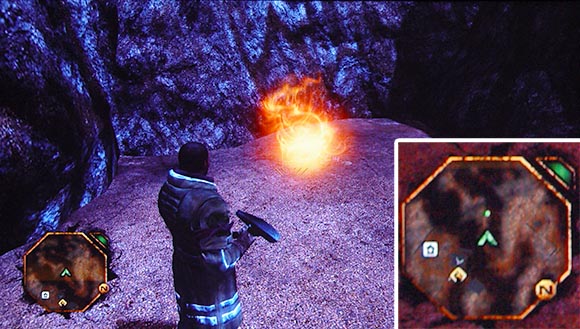
In case you’ve been wondering how a “Radio Tag” looks like – well, it’s a burning orange fireball! Of course. At least it is clearly visible in the game world and on the mini-map.
From all the collectibles in the games, the radio tags are technically the most polished ones. There are 36 radio tags in the game. They are completely optional. You get a clear feedback on how many there are and how many you are missing. They appear as a small fireball in the world (wtf?). They also appear as bright green dots on the mini-map which makes them quite easy to find if you are happen to be in vicinity. Sadly, getting in their vicinity is the problem. There are no hints on where you might want to look for them. The game word is separated into sectors but the number of collected radio tags is a global one. So you don’t even know if you found all radio tags in a given sector. When you played through the entire game and still haven’t found all of them, the only options that remain are either mindlessly driving around and hoping for the best OR grabbing a game guide. Both of them are signs that the collectible is flawed, I think.
On a more positive note, you get rewarded with a car bomb for every three radio tags you collect. I think such progression rewards are a quite overlooked design detail. They allow players, who are not quite as OCD about collectibles to still get some enjoyment from them.
Another good detail is how each radio tag has a distinct identity. After collecting you get a small voice recording and a photo (of the developers, I believe).
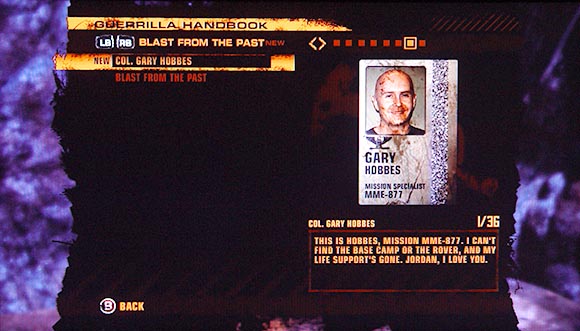
Good: Each radio tag has a distinct identity and comes with a small piece of narrative. If only the other collectibles were of the same quality…
This has two advantages. First, it enriches the game word to hide bits of background story in such way. At least it’s better than having collectibles with no connection to the narrative at all. Secondly, it allows players to identify the collectibles they are still missing when they use game guides (print or Internet). This is especially important in this case because of a small flaw that many collectibles share: the radio tags disappear without a trace after they have been collected. Without the distinct identities it would be difficult to tell which ones you already got.
Mineral Deposits
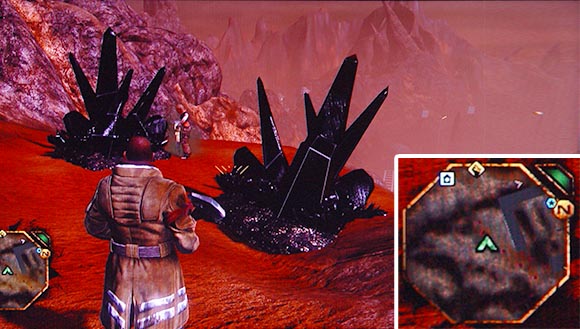
UI colors pop quiz. How would you judge the legibility of tiny pale red dots on a otherwise rust-red mini-map?
Besides the radio tags, you can also collect mineral deposits. Now get this: there is a mind-blowing 300 of them! And you need to collect each and every one to get the associated achievement. Unlike with radio tags, the progression rewards are minuscule. You get “money” for destroying the deposits but you get money for destroying pretty much anything in the game. So it’s either 300 or nothing. And again, you get no hints on where to look for them. But now they are even harder to find. They do appear on the mini-map like the radio tags. The problem is that they show up in red. Because the entire planet is red, they are almost invisible. You will miss them even if you pay attention.
But not everything is quite as bad. 300 sounds daunting but the blow is lessened since the deposits tend to appear in clusters of around 5 or so. They look like big black crystals, quite distinct and visible in the game world. You collect them by smashing them with a hammer. That action by itself is oddly rewarding. It has also some practical side-effects. After smashing the crystal, a stump remains so you can tell for sure if you collected it later on. Sadly you still have to personally visit each and every location to check. Collected crystals don’t appear on the map.
So in the end, this still is a brutal collectible. There is no way a normal person will find them all without a guide and some tedious, obsessive searching.
Propaganda
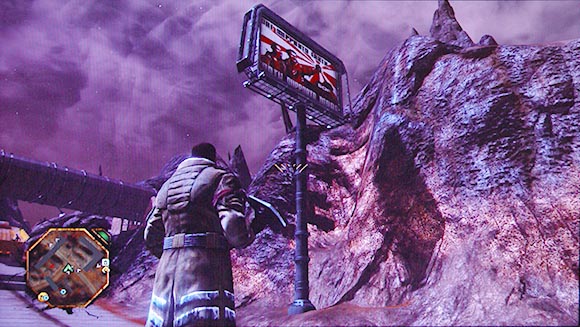
Propaganda doesn’t show up at the mini-map at all but on the other hand, it was easy to find all instances. I wonder why.
When you compare all the collectibles on paper, you might think that the propaganda billboards are even more difficult to find. They don’t even show up on the mini-map and you need destroy all 50 of them. But I must admit that compared to the crystals, it’s actually not that bad. They are huge and often mounted on very tall poles. The only problems that came up during my play trough happened due to “Collateral Damage” sub-missions. In these missions, you control a turret on a AI-controlled vehicle. You goal is to cause a certain amount of destruction. At the end of the mission, all the damage you have done is being reversed. It is a bit confusing if you destroy propaganda billboards during such a mission. I still don’t quite understand if that still counts as collecting. Also, in latter levels, you come across billboards that are suprisingly difficult to destroy and difficult to recognize as destroyed. Nevertheless, this was the only collectible I was able to get without much effort and without having to use a guide which counts as a successful collectible in my book.
Supply Crates
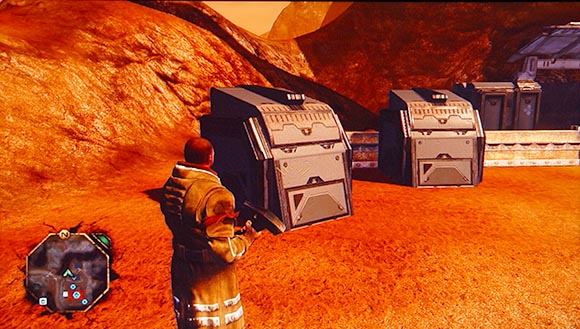
Wait, could it be that the EDF are trying to assemble an army of AT-STs?
Here is where things get odd. You are also prompted to destroy 250 EDF (Bad Guys Inc.) supply crates. Like propaganda billboards, they don’t show up on the map. They are also quite difficult to spot. There are various kinds of crates and boxes in the game and the supply crates have very few features that distinguish them from other kinds of crates.
But the weird thing is that there are far more supply crates in the game than 250. So you don’t need to collect all of them. I haven’t seen such a setup like that very often and it certainly helps to alleviate the pressure associated with collectibles. Every player knows: when the goal is to get 100% of a collectible, you will quite often get in that situation where you have 99% and spend way too much time frustrated looking for that last 1%. So actually, getting this collectible was quite relaxing. You aren’t forced to interrupt everything you do every time you spot one of the crates. It’s OK to miss some of them.
Otherwise, they are similar to the mineral deposits. They need to be destroyed to get them which feels good. They also give you a very small reward – just money.
Other Achievements
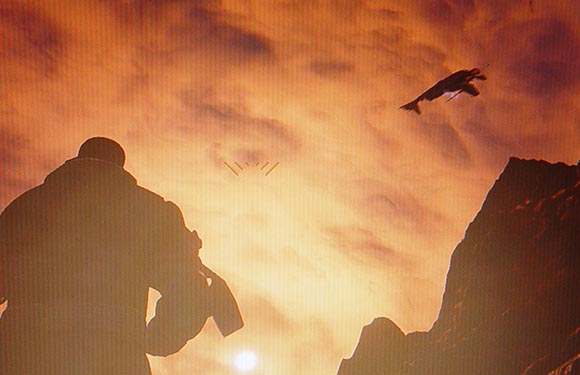
On Mars, there are even flying collectibles.
The interesting thing is how the supply crates form a missing link to other achievements, which aren’t quite collectibles. So for example, you are challenged to shoot down 50 EDF Flyers. These are basically just helicopters. They sometimes spawn by the end of the game and can be tricky to shoot down. Just like supply crates, you just have to destroy a certain number of them. But unlike collectibles, there is an unlimited supply of them. Also, they aren’t static and hidden in pre-defined places but appear randomly and dynamically.
There are also some other, similar achievements. For example you have to blow up a certain amount of hydrogen tanks or destroy a certain amount of special, valuable buildings. While they all aren’t technically collectibles, they have a very similar vibe. Especially because of the supply crates as “missing link” they extended the variety of collectibles up to a point where the game feels even more like an excessive collectible frenzy.
Guerrilla Actions
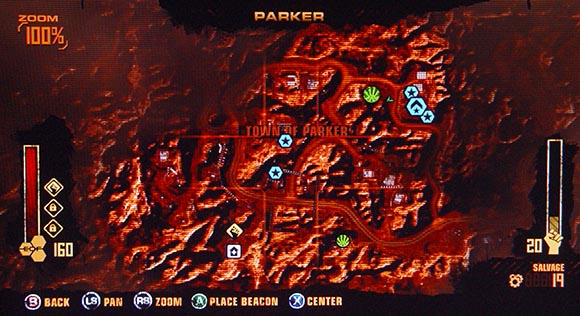
The first sector of the game. Note that 2 Guerrilla Actions (green) appear on the map while there are actually 6. 2 Appear later but the remaining 2 will never be visible. Not an ideal system to do a collectible hunt in.
And then there is yet another game mechanic which shares characteristics with collectibles. During the game, you may engage in side-missions called Guerrilla Actions. Doing a small amount of them is mandatory for progress in the main story but there are a lot more of them than necessary. You will find over 100 Guerrilla Actions throughout the game. With time they do get somewhat repetitive and stretch out the gameplay quite a bit. However, I found them actually quite well-made. There are just a handful of different types. You know in advance what type of mission you are about to start so you can pick the ones you prefer. They are all quite solid and focused around the strengths of the game. You destroy buildings, break into buildings to rescue prisoners, set up explosive traps for military convoys, or simply wreak havoc in nearly indestructible mechs. So yes, you do things over and over again but those things are actually quite enjoyable.
There are achievements associated with completing a certain amount of Guerrilla Actions. One of them is given for completing all of them. Which brings us to a small problem. Most of the Guerrilla Actions are easy to find and easy to trigger. You see an icon on the big overview map, you can even set a waypoint there, you go to the specified place and speak to a clearly highlighted person. However, there are some Guerrilla Actions that work differently. Driving through the landscape, you sometimes randomly and spontaneously receive a radio message prompting you to engage in one of them. These special radio Guerrilla Missions are a source of some great frustration. They don’t appear on the map unless they are currently active so you never have a clue how many of them there are. After you completed them, they don’t appear anywhere either so you can’t even tell which ones you’ve already finished and which ones you missed. Since they are triggered randomly, it is impossible to restart them after you’ve failed or start them on purpose. The general strategy to get them is to drive around and keep your fingers crossed. Finally, even if you aren’t collecting them, they are generally just a poor idea. The game does a good job of giving you a lot to do. You never drive around thinking “Man, I wish some random side mission would suddenly pop up out of nowhere”. Generally, you are always on your way to do something. The radio Guerrilla Actions just get in the way. You feel obliged to follow upon them because of both: story and completionist reasons. But they are never really welcome.
There is yet another inconvenience. In the game, you “liberate” mars sector by sector. If you liberate a sector before you finished some of the Guerrilla Actions in it, they will just disappear. They will re-appear when you finish the main story missions but you won’t be able to engage in those Guerrilla Actions until then. This also applies to the already invisible radio Guerrilla Actions.
And just like with the other collectibles, you can’t tell how many Guerrilla Actions there are in an individual sector. You also can’t tell how many Guerrilla Actions you’ve already completed in an individual sector. The regular Guerrilla Actions appear greyed-out on the map if you already finished them but there is always that unknown number of radio Guerrilla Actions which makes that information useless. Reading forum discussions, you will often encounter players chasing for hours for that one last radio Guerrilla Action, having no clue where to look for it. I guess I was lucky to be able to get all of them but even for me, the experience was tainted by ambiguity.
DLC: Power Cells
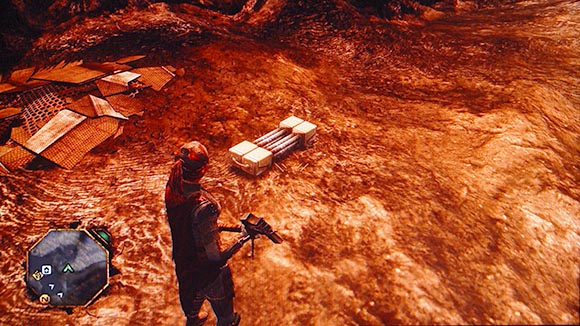
Ah, finally we reached the bottom. Random junk you need to collect.
As many games today, Red Faction: Guerrilla comes with a DLC. Compared to the other DLCs, I found it actually quite weak. It is complicated to launch it. It is not integrated into the main game at all. Some of the game mechanics like the money and upgrade system are missing. The story is laughable and the levels look ugly. There are a few new weapons and vehicles but they I didn’t find them appealing, just more cumbersome to learn.
But never mind that. The DLC comes with it’s own collectibles. One of them are the power cells. Next to stars (and it is always stars) power cells are the second thing that for some reason needs to be collected in games. I guess we owe it to Jak & Daxter. Thank you Jak & Daxter.
Everything got a tiny bit worse in the DLC including the collectibles. This time, no real explanation as to why you need to collect the power cells. Just because. You need to collect 75 of them, trust me on this one. They do not appear on the map. You also don’t know which ones you’ve already collected. They are pretty inconspicuous in-game, often hidden inside a shed mounted on a side of a cliff. Finally, there is almost no reward for collecting them. I think you get a “cheat” for collecting 75 but I never bothered experimenting with that.
As a redeeming quality, there are more than 75 power cells out there so you can miss some of them. Quite like with the EDF supply crates. But all in all, having completed the main story of the DLC, I found only very few of the cells. Looking for the remaining ones was far from enjoyable and not rewarding at all.
DLC: Totems

By saying “This is a random pile of junk you need to destroy” I already did more background-story than the game does.
And because this is Red Faction: Guerrilla, having just one kind of collectibles in the DLC wouldn’t be enough. You also need to destroy 4 war totems. Again, I don’t quite understand why. Of course, they don’t appear on any map either. This time you need all of them but at least there are only 4. During a my playtrough I found only 1. As I don’t remember the rewards, they were probably pretty forgettable.
Come to think of it, I found it pretty difficult to come up with a suitable reward for such a collectible. The only reason to continue playing the DLC past the missions is to get the collectibles. So whatever the reward would be, it would either need to be something you can enjoy without having to continue playing the DLC or something that would motivate even more DLC gameplay in itself. But if you came up with the latter, wouldn’t it that make the collectible obsolete?
Conclusion
To sum it up, I think Red Faction: Guerrilla offers a lot of food for thought for collectibles. There are a few mistakes:
- Bad proximity feedback: In most cases players receive poor or no feedback at all if they are in proximity of a collectible. The only exception being the radio tags. They are clearly visible on a mini-map. This kind of information is a vital requirement for the successful implementation of collectibles in a game like this.
- No segmentation: Even though the game is separated into sectors, the amount of collected and remaining collectibles is given always globally. Giving more detailed, sector-based information on progress in collectibles facilitates the end-game part of a collectible hunt which often turns out to be the most frustrating one.
- No information on already collected items: Like almost every game, Red Faction: Guerrilla ignores the player’s need to know and identify which collectibles exactly they already obtained. The radio tags can be identified by their name but even in this case, a map overview is missing. Again, this information becomes vital in the end-game part of a collectible hunt.
- Poor story tie-in: The collectibles in the DLC have an especially poor story tie-in. The motivation of the main character is unclear at best. The collectibles don’t represent any kind of value within the story. It’s just random junk. Collectibles take a lot of time. Game designers should make sure players understand why they might want to invest that effort.
- Weak rewards: Especially in the DLC, the collectibles offer poor rewards. In most cases the biggest reward is the achievement in itself rather than any in-game resources or abilities. Even worse, there is even rarely a promise of a reward. One of the most important concepts in dramaturgy are set-ups and pay-offs. Collectibles often fail in both.
- Too many collectibles: As evident by the length of this article, the game contains too many collectibles. The impression is strengthened by other challenges, which share characteristics with collectibles. The DLC even comes with it’s own, poorly polished and superfluous set of collectibles. They increase the length of the game but provide no additional substance. As a result they come off as a cheap trick.
There are also a few solutions that work well:
- Progression Rewards: collecting the radio tags yields rewards even before all of them have been collected. This makes the entire process of collecting them more rewarding and diminishes the focus on reaching 100%.
- Less than 100% requirement: In the same vain, collectibles like the EDF supply crates count as obtained well before all availible instances have been collected. Again, this simplifies the often frustrating end-game of collecting them.
- Rewarding act of collecting: The act of actually collecting a collectible is often quite rewarding. In the case of the EDF supply crates, propaganda billboards or mineral crystals, it involves smashing a large structures into pieces. When designing collectible mechanics, it is worth considering such small details to enhance the experience.
- Distinct identity for each item: In the case of radio tags, each individual item has a distinct identity. It is clearly distinguishable from the rest and comes with a small bit of narration. This helps in searching for the collectibles as players can tell more easily which ones they got and which ones they are missing. It also makes the collectible a more valuable and integrated part of the overall narrative.
I believe many of the mentioned aspects is something we will encounter in following reviews of collectibles. Until then, feel free to comment and share with us your experiences.






Really good analysis. Looking forward for more, although it might be hard to eclipse RF.
As for randomly spawning missions, they also usually leave no time after appearing, like a convoy being intercepted will reach the destination in limited time. So, if you are caught while low on ammo, especially in the beginning, tough luck, there is no time to resupply.
Somehow Mass Effect 1’s minerals, ID tags and other useless stuff to collect tastes even worse after reading this.
I found Batman AA’s collectibles to be the most rewarding yet. I also enjoyed red faction but some of the missions were really unrealistic more like one man versus an army